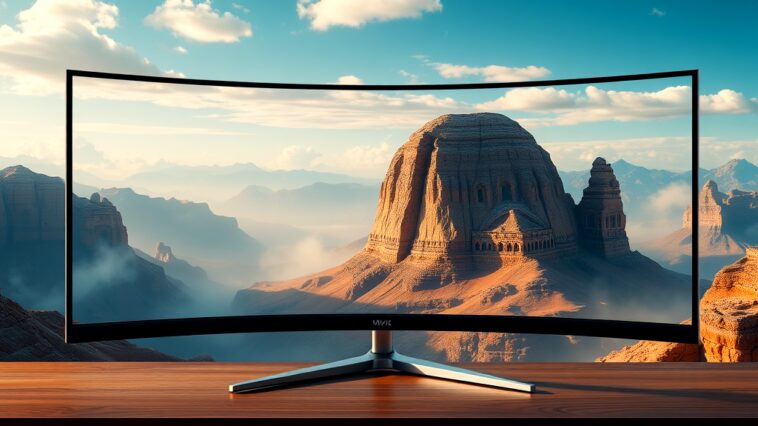Introduction
In a world where screen real estate is increasingly important, ultrawide monitors have emerged as a popular choice for many users. These monitors offer a unique viewing experience, allowing for more content to be displayed side by side, which can enhance productivity and entertainment alike. This article aims to evaluate whether investing in an ultrawide monitor is valuable, providing insights into their benefits and potential drawbacks.
Understanding UltraWide Monitors
Definition of UltraWide Monitors
An ultrawide monitor is designed with a wider screen compared to traditional monitors. Typically, these monitors come with aspect ratios of 21:9 or 32:9, allowing users to see more content horizontally without the need to scroll or switch between tabs.
Aspect Ratios: 21:9 vs 32:9 (Super-Ultrawide)
- 21:9 Aspect Ratio: This is the most common ratio for ultrawide monitors and closely resembles the cinematic format used in movies. It is ideal for multitasking or watching films without black bars.
- 32:9 Aspect Ratio: Known as super-ultrawide, this ratio is effectively two 16:9 monitors side by side. It offers an expansive view, making it ideal for gamers and professionals who need extensive workspace.
Comparison to Standard 16:9 Monitors
In comparison, standard monitors typically have a 16:9 aspect ratio. While they are sufficient for general tasks, ultrawide monitors provide a more immersive experience for both work and entertainment. The extra horizontal space is beneficial for multitasking, allowing users to view multiple applications simultaneously without overlapping windows.
Key Features of UltraWide Monitors
Horizontal vs Vertical Screen Space
The primary advantage of ultrawide monitors lies in their horizontal screen space. Users can arrange their applications side by side, which is especially beneficial for tasks that require multiple open windows. This feature allows for a more efficient workflow, reducing the need to toggle between programs.
Popular Screen Sizes and Their Comparisons to 16:9 Monitors
Common screen sizes for ultrawide monitors range from 34 inches to 49 inches. A 34-inch ultrawide monitor can provide the same vertical space as a 27-inch 16:9 monitor while offering significantly more horizontal space. For those who need even more visibility, a 49-inch super-ultrawide monitor can replace a dual-monitor setup.
Advantages of Extra Horizontal Space
The extra horizontal space on ultrawide monitors is advantageous for several reasons:
- Multitasking: Users can view documents, spreadsheets, and websites side by side without the need for multiple monitors.
- Enhanced Gaming Experience: Gamers benefit from a broader field of view, resulting in a more immersive experience.
- Improved Focus: With more content visible at once, users can maintain their focus without distractions.
Evaluating the Value of UltraWide Monitors
For Office Work
Benefits of Ultrawide Monitors for Productivity
Ultrawide monitors have proven beneficial for productivity in office settings. The ability to view multiple applications simultaneously can streamline workflows, making tasks like data analysis, programming, and content creation more efficient.
Cost Comparison: Ultrawide vs Standard Monitors
While ultrawide monitors can be more expensive than standard models, the investment may be justified in terms of productivity gains. A high-quality ultrawide monitor may cost between $400 to $1,200, while standard monitors typically range from $150 to $600.
Recommendations for Specific Sizes and Resolutions
For most office applications, a 34-inch ultrawide monitor with a resolution of 3440×1440 is recommended. This configuration strikes a balance between screen size and resolution, providing ample workspace without sacrificing image quality.
For Watching Videos
Advantages of 21:9 Monitors for Cinematic Content
Ultrawide monitors are particularly advantageous for watching movies, especially those shot in a 21:9 aspect ratio. This format eliminates black bars, allowing for a full-screen cinematic experience.
Handling of 16:9 Content on Ultrawide Displays
While 21:9 monitors excel at displaying cinematic content, they can also handle 16:9 content effectively. Most ultrawide monitors will display 16:9 content with black bars on the sides, but some offer settings to stretch the image to fill the screen.
Limitations of 32:9 Monitors for Video Consumption
Though 32:9 monitors provide an expansive view, they may not be ideal for video consumption. Most films are produced in 21:9, meaning that 32:9 displays will often result in significant cropping or black bars.
For Editing
Importance of Color Accuracy for Editing Tasks
For video and photo editing, color accuracy is crucial. Many ultrawide monitors come with advanced color calibration and wider color gamuts, making them suitable for professional editing tasks.
Benefits of Ultrawide Displays for Timeline Visibility
The extra horizontal space on ultrawide monitors is particularly beneficial for video editing. Users can see an entire timeline without scrolling, allowing for smoother editing workflows.
Cost Comparison with Standard Monitors for Editing
While high-quality ultrawide monitors can be pricier, they often provide better features for editing tasks compared to standard monitors. Investing in a good ultrawide monitor can enhance the editing experience significantly.
For Gaming
Compatibility Issues with Console Gaming
One downside of ultrawide monitors is compatibility with gaming consoles. Most consoles are designed for 16:9 output, meaning they may not utilize the full screen of an ultrawide monitor, resulting in black bars.
Advantages for PC Gaming: Field of View and Immersion
For PC gaming, ultrawide monitors provide a wider field of view, enhancing immersion in games. Titles like “Cyberpunk 2077” and “Battlefield” support ultrawide resolutions, enriching the gaming experience.
Limitations in Competitive Gaming Context
While ultrawide monitors offer advantages in immersion, they may not be ideal for competitive gaming. Many professional gamers prefer 16:9 monitors for their standardized performance and response times.
Popular Games that Support or Don’t Support Ultrawide Resolutions
Many modern games support ultrawide resolutions, including:
- “The Witcher 3”
- “Doom Eternal”
- “Assassin’s Creed Odyssey”
However, older titles or certain indie games may not support these resolutions, leading to potential black bars or stretched images.
Troubleshooting Common Issues
Fixing Black Bars in Games with Ultrawide Support
In games that support ultrawide resolutions but still display black bars, users can often adjust the settings in the game menu. Look for a “resolution” or “aspect ratio” option to select the appropriate ultrawide setting.
Using Mods and Hex Editors for Gameplay Adjustments
For games that do not natively support ultrawide resolutions, players can use mods or hex editors to adjust the game’s display settings. This requires technical knowledge but can enhance the gaming experience.
Limitations with Pre-rendered Cutscenes
A common limitation with ultrawide monitors is that pre-rendered cutscenes may not support the wider aspect ratio, resulting in black bars. This is usually a design choice by the game developers and cannot be adjusted.
Conclusion
In summary, ultrawide monitors can be a valuable investment depending on your specific needs and preferences. They excel in multitasking, cinematic experiences, and editing tasks. However, potential users should consider the limitations in gaming and the initial investment cost. Ultimately, the decision to purchase an ultrawide monitor comes down to individual use cases and whether the benefits align with your needs.
If you have any questions or want to share your experiences with ultrawide monitors, feel free to leave your comments below!
Other Related Articles
- Eizo Foris FS2331 Review
- How Much Power Does a 144Hz Monitor Use? A Deep Dive into Energy Consumption
- Should I Turn On HDR for Gaming? A Comprehensive Guide
- Is iPhone 16 Pro OLED the Best Display Yet?
- Understanding Panel Variance: What It Means for Your Monitor Purchase
- Can You Throw Computer Monitors in the Trash? The Ultimate Guide to Eco-Friendly Disposal
- Understanding VESA ClearMR: The Future of Motion Clarity in Displays
- 4K vs 1080p – Is UHD Worth The Upgrade?
- How To Choose The Right Gaming Monitor: A Comprehensive Guide
- IPS vs OLED Monitors for Color Accuracy: The Ultimate Showdown
- HDMI 2.1: The Future of Home Entertainment and Gaming
- How to Connect Heart Rate Monitor to PC?
- Curved vs Flat TV – Which Should You Choose? The Ultimate Showdown for 2025
- Can You Connect M-Audio Monitors to PC?
- Why Is My PC Showing the Same Display on Two Monitors?
- Why Are Computer Monitors More Expensive Than TVs?
- The Best Flicker-Free Monitors for Eye Care
- Monitors for Mac vs Windows PCs: The Ultimate Showdown
- 1920×1080 vs 2560×1440 – Which One Should I Choose?
- 99219444 Toshiba and Its Revolutionary Features for Tomorrow’s Tech Landscape
- OLED vs QD-OLED: The Showdown of Display Technologies
- What Is DisplayPort 2.1?
- What Is The Best Monitor Size For Gaming?
- 720p vs 1080p vs 1440p vs 4K vs 8K – Which Should I Choose?
- Is An HDR Gaming Monitor Worth It?
- Mini-LED vs MicroLED: What’s the Difference?
- Do Pawn Shops Take Computer Monitors?
- What LG Computer Monitor is as Good as the C3?
- Understanding Pixel Walk and Pixel Inversion
- Curved vs Flat Monitors for Work: Which One is Right for You?
- What Is The Soap Opera Effect?
- 4K vs 1440p Monitors for Video Editing: Which One Should You Choose?
- Do I Have to Attach a Hood to My BenQ Monitor?
- Can You Use Mac as a Monitor for PC?
- What Is G-SYNC And What Does It Do?
- Daz Studios Summoner G8 for the Visionary Artist
- Dell vs HP Monitors for Gaming
- Understanding IPS Technology: A Comprehensive Guide
- 27-Inch Monitors vs 32-Inch Monitors for Productivity
- Understanding Screen Resolution: Why It Matters for Your Displays
- How to Transport Computer Monitors?
- How to Dispose of Computer Monitors?
- What Is 4K Resolution And Is It Worth It?
- How to Pack Computer Monitor for Moving?
- What Is HDR For TVs And Is It Worth It?
- 1440p or 144Hz – Which Is Best For You?
- USB Type-C Explained – Everything You Need To Know
- Samsung’s Exciting Journey into Glasses-Free 3D Displays at Gamescom 2024
- I Have A Problem with My Samsung Odyssey G3 Monitor Setup
- Is A 144Hz Monitor Worth It? A Comprehensive Guide
- Understanding FALD Blooming and the Halo Effect: A Deep Dive
- What Does 144Hz Mean? Understanding Refresh Rates in Simple Terms
- Is an UltraWide Monitor the Right Choice for You?
- Active vs Passive 3D – What’s The Difference?
- Understanding Glare Control in Luminaires for Computer Users
- Why Does My Acer Monitor Keep Going Black?
- Understanding Motion Blur Reduction: A Gamer’s Guide
- How to Connect Studio Monitors to PC?
- Misleading Monitor Specifications You Should Look Out For
- QLED vs OLED – Which Is Best?
- Understanding VESA AdaptiveSync and MediaSync: The Future of Display Technology




